Some local news is easy to ignore. Elected officials come and go. New laws receive spirited debate, but usually result in only minor changes. But when a dilapidated building in the center of your town is renovated or a wooded lot where generations of children played is cleared for a new luxury resort, it affects the entire community.
The impact is almost never simply good or bad. A project that promises to create a few dozen new jobs and bring millions of dollars in economic activity will also create more traffic and noise, particularly for those who live nearby. Environmental and aesthetic concerns aside, the type of development matters. Many of the pending projects in our area are clearly aimed at well-heeled tourists from New York City and other urban areas. On their websites, developers stress the proximity of these cities on a map of the Northeast and stress the region’s bucolic charms. As a local, this creates mixed feelings. If given a choice, we’d like to see development that creates a variety of good-paying jobs. We don’t want to become merely a playground for the rich. At the same time, an influx of money generally benefits small businesses that otherwise wouldn’t be able to turn a profit.
Though as residents we can’t choose what developers and property owners propose, we can have some influence over whether it’s approved by the relevant local authorities. Every town and city has a zoning code that divides it into different sections and spells out what sort of development is allowed in each. There’s usually also a master plan that describes broader goals for development in the future. Residents who want to challenge proposed developments effectively base their arguments on these documents. They can also question the findings and rigor of the environmental impact statement, a study required of all significant developments that spells out not just the effect on the natural world (as “environment” implies), but also the economic and social impacts. Beyond that, many developments are proposed (or already exist) in areas where the zoning should prohibit them. They require variances and special-use permits, issued by local boards in public meetings following public hearings, offering residents further opportunities to influence the process. (The effect goes beyond the persons in the room- if the development is happening in a community we cover closely, we almost always have a reporter at the meeting, and concerns voiced by neighbors always make it into our coverage.)
The first step is to keep track of what’s being proposed in your community. This is harder than it seems because the review process can take many years. You might have heard five years ago that a big hotel was going to be built on the corner, but there’s been nothing since. Is it dead? Perhaps. Maybe the funding dried up. Or maybe the developer just wanted to secure approval for a project on a piece of land before bothering to line up financing, and a crucial public hearing is just around the corner.
For those who want to weigh in on local development, or just want to know what’s happening at the construction site they pass each day, we present this roundup of local pending development projects in our main readership area. We hope you find it useful.
New Paltz area
Zero Place

Rendering of Mulberry Plaza at Zero Place
Where: Corner of Mulberry St. and Rt. 32N, village of New Paltz
Developer: David Shepler
What: A mixed-use development with 46 apartments and retail shops on the ground floor. The project’s name comes from its net energy use which, thanks to 15 geothermal wells and 260 kilowatts of solar power, should be zero. At four floors and with a footprint of over 17,000 square feet, the building will be significantly larger than anything else in that part of the village. When it was first proposed in early 2016, the project attracted attention from residents concerned about its impact, such that developer David Shepler said at times he thought the project might not happen. Modifications were made to the building height and other aspects of the plan in response to concerns and it was approved last year, with ground broken in December.
2019 forecast: Will be under construction throughout 2019 and open in early 2020.
Wildberry Lodge & Spa
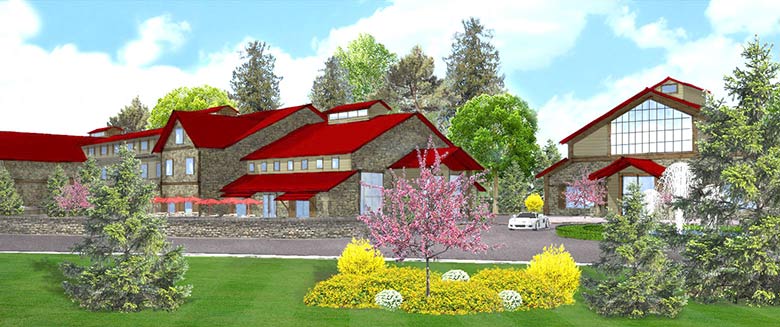
Where: New Paltz, Rt. 299 and South Ohioville Rd.
Developer: Steve and Shelley Turk, who also own and operate Rocking Horse Ranch in Highland and SplashDown Beach water park in Fishkill.
What: A 90-room hotel with conference center and restaurant; a multi-purpose space holding approximately 500 guests will be in a stand-alone 11,000-square-foot “modern barn” structure with “breakout” rooms that can host simultaneous meetings; Wildberry Botanical Spa & Wellness Center: a full-service spa with 12 to 16 therapy rooms, an open space studio for yoga and meditation, a fitness center, mineral springs and an indoor-to-outdoor swimming pool; tiered open-air outdoor amphitheater seating up to 500; a greenhouse adjacent to a 15,000-square-foot butterfly conservatory showcasing hundreds of butterfly species; a “treehouse and canopy adventure” is planned on the grounds, as well, along with zip lines, rope courses and adventure climbing. The site rendering also depicts artist studios and a sculpture garden in the mix, and a wetlands observation deck to overlook the eleven acres of bird sanctuary and wetlands on the 33 acres of the property to be left undeveloped.
2019 forecast: Developers want to break ground this summer, but the environmental impact statement is still not complete, the project has not been approved by the town and the Pilot (payment in lieu of taxes) agreement has not been finished. We’d be surprised if construction began this year.
Heartwood
Where: Gardiner, Rt. 44/55, on the northern bank of the Shawangunk Kill, next door to the Tuthilltown Spirits distillery
Developer: Kristin and Phillip Rapoport, doing business as Shinrin Yoku, LLC. Phillip Rapoport told the Gardiner planning board that they came up with the idea of creating such an eco-resort after years of visiting the area regularly to hike and climb in the Gunks, and feeling that the area lacked a “launching pad” for such active tourism.
What: Seventy-unit boutique lodging facility, farm and restaurant on 141 acres, capable of hosting over 100 guests at one time. Central amenity building with main lobby, restaurant, spa, event space for weddings, yoga and meditation, plus 70 exterior cabins for guests, tennis and bocce courts. Twenty-eight of those cabins will be “eco-cabins” for visitors who want closer proximity to nature.
2019 forecast: The planning board is scheduled to vote on the project later this month. If approval is granted, developers say construction could begin this year. Update: The project has been approved by the Gardiner Planning Board.
Williams Lake Resort
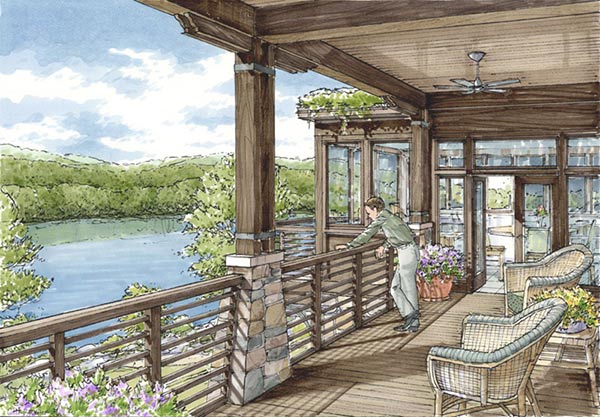
Where: Williams Lake Road, Rosendale
Developer: Hudson River Valley Resorts, LLC
What: Resort hotel/spa and residential community on nearly 800 acres. Last year, the town approved phase two of the plan, which calls for 120 housing units consisting of 78 town homes and cottages, 34 detached homes and 8 workforce units.
2019 forecast: The hotel and spa are currently in the design process, with construction anticipated to begin late this year.
“Dollar General” project
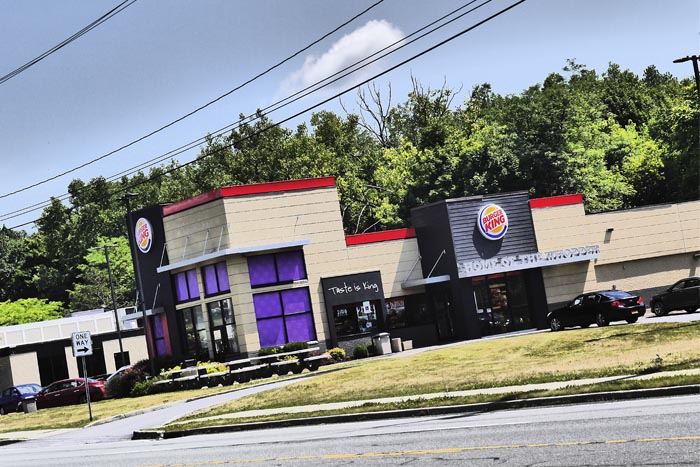
The public hearing for the Dollar General project in Lloyd will resume on July 26. Three parcels, totaling 21.7 acres, along Route 9W and including the existing Burger King, Trustco Bank, and a strip mall are included. A Dollar General would be constructed on one of those lots, and a 72-unit apartment complex would be built behind those businesses, with the strip mall refurbished to match. (Photo by Lauren Thomas)
Where: Route 9W in Lloyd
Developer: MCBS DG Highland, LLC
What: The so-called Dollar General project is much larger and more complex than the nickname might suggest. Three parcels, totaling 21.7 acres, along Route 9W and including the existing Burger King, Trustco Bank, and a strip mall are included. A Dollar General would be constructed on one of those lots, and a 72-unit apartment complex would be built behind those businesses, with the strip mall refurbished to match. One more lot created along Route 9W would not be developed as a part of this plan.
2019 forecast: The project was approved last fall. Final conditions included an agreement to clean up contamination found, though testing up to this point hasn’t turned up any.
Ferris Woods

(Photo by Lauren Thomas)
Where: Brouck Ferris Boulevard, off 299, New Paltz
Developer: Panessa family
What: Senior housing with 60 two-bedroom units.
2019 forecast: Last discussed in summer 2017, the project appears to be on hold at the moment.
Kingston & Ulster
Irish Cultural Center of the Hudson Valley
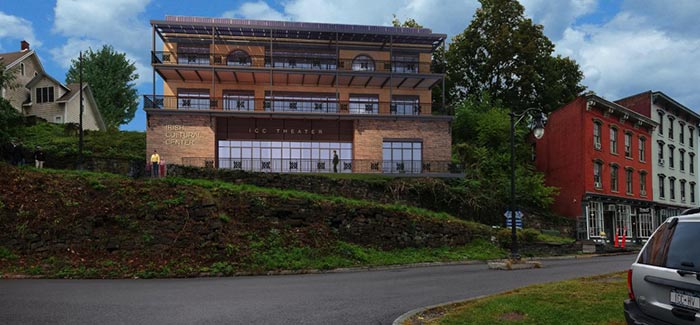
(Architect’s rendering)
Where: Abeel Street in Kingston’s Rondout neighborhood
What: A three-story, 16,000-square-foot building on a vacant lot at 32 Abeel St. Plans call for a community hub which would include an Irish pub, 171-seat theater and classroom space for instruction in traditional Irish dance, music, sports and Gaelic. The center would also serve as office space for the group. First conceived in 2011, the project has faced opposition from neighbors concerned about noise, traffic and size.
2019 forecast: It received site-plan approval last spring, but developers missed a crucial deadline in applying for a permit and will need to start the process over again this year. Assuming it will be approved again, construction could begin later this year.
Lincoln Park grid support center power plant
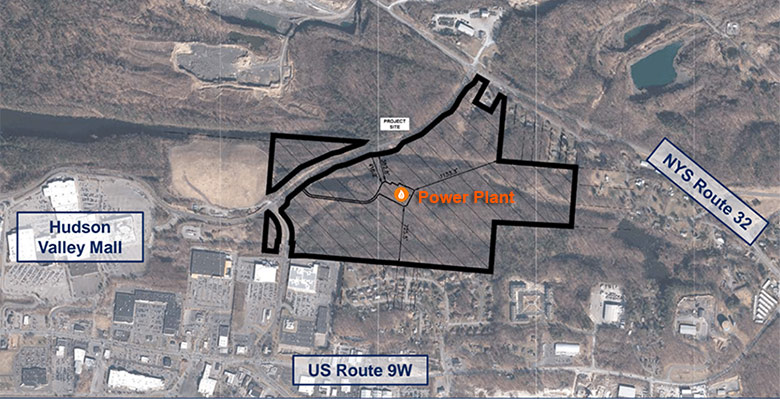
Where: Town of Ulster, at Miron Lane and Frank Sottile Blvd. (behind and to the northeast of the Hudson Valley Mall)
Developer: Glidepath Power LLC., based in Chicago
What: Natural gas-fired power plant with diesel backup and 20 MW lithium ion battery array for storage. The plant would operate on a small parcel of a 121-acre site off Frank Sottile Boulevard. The building housing the equipment would stand for between 30-40 feet in height; with a 70-80-foot exhaust stack. The project drew criticism from neighbors and county executive Mike Hein, who said the plant would benefit downstate customers and investors while locals experienced the downsides of noise and air pollution. The company pointed to studies that concluded the entire region needs more power capacity, not just downstate.
2019 forecast: Glidepath previously had said it hoped to begin construction in 2019, but also planned on releasing the environmental impact statement for the project by the end of the year. That was pushed back to early 2019.
The Kingstonian

A rendering of the Kingstonian, with North Front Street in the foreground.
Where: Uptown Kingston, North Front St. and Fair Street Extension
Developer: JM Development Group LLC, based in New Windsor, partnering with the Jordan family’s Herzog Supply Co.
What: Two buildings straddling Fair Street Extension, one where the current brick warehouse structure used by Herzog’s now stands and the other where the city parking lot now sits. The plan calls for 129 “market-rate” rental units. The project is also projected to contain 8,000 square feet of commercial space, expected to include one or two restaurants — Elena’s Diner at the bottom of the hill will be demolished — small retail tenants and, possibly, a bank tenant. The brick warehouse, which began life as the first Kingstonian more than 100 years ago, will be rebuilt for a 32-room boutique hotel. Also, a 420-space parking lot, with 250 spots for public use.
2019 forecast: If all goes smoothly with the site plan and state environmental quality review, they hope to begin work in the fall of 2019 with a total construction time of 18 months. That’s an optimistic schedule. As of early January, nothing had been submitted to the city planning board. We don’t expect shovels to hit the ground this year.
HealthAlliance hospital expansion

Where: Kingston, St. Mary’s Campus (formerly Benedictine Hospital)
Developer: HealthAlliance
What: A $92-million plan to centralize hospital services at the St. Mary’s Ave. campus. Plans call for the construction of a new two-story, 79,000-square-foot structure with 175 beds, most of which will be private. Plans also call for renovation of existing structure.
2019 forecast: Construction this year unlikely. In early 2018, a completion date of late 2020 was given, though plans have been revised since then.
Formerly Supergarage Rondout project
Where: Along the Rondout Creek, off Rondout landing, east of the Maritime Museum and lower Broadway
Developer: Robert Iannucci
What: A 12,500-square-foot boat restoration facility and museum to house Iannucci’s collection of four World War II-vintage PT boats. The plan also calls for 60 apartments, retail space, a rooftop swimming pool and skating rink and about 175 parking spaces.
2019 forecast: The project was first brought up at the end of 2018, so there’s very little chance of anything happening for a few years.
Three Rupco projects
Where: Midtown Kingston
What: The non-profit Rural Ulster Preservation Company will have another busy year, with three developments either under construction or pending before the city planning board. The total cost of all three is over $70 million.

- Energy Square: A mixed-use development at the former Mid-City Lanes bowling alley on Cedar Street. The building will include 57 units of affordable housing in a building ranging from three to five stories, with commercial tenants on the ground floor. The building will be “net zero,” offsetting its energy use with geothermal and solar power. Now under construction, it’s expected to be complete this fall.
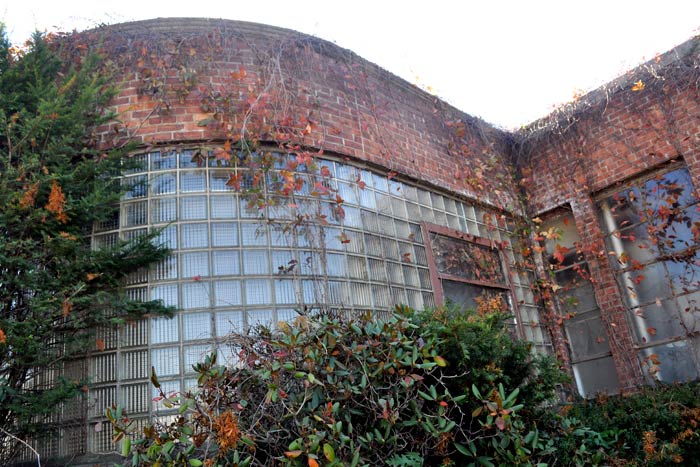
Rupco & Mary Stuart Masterson’s Stockade Works would like to transform the cavernous former MetLife building on Greenkill Avenue in Kingston into a TV/film production studio and training center. (Lauren Thomas | New Paltz Times)
- The Metro: A 70,000-sq-ft warehouse on Greenkill Ave. Plans call for $14 million in renovations, with the location hosting actress Mary Stuart Masterson’s non-profit film production company, Stockade Works, as well as additional space for film and other creative “makers” to set up shop. No new building construction is planned and the city has signed off on the plans. Work should be ongoing in 2019.

- Landmark Place: The conversion of the former Alms House on Flatbush Ave. into 66 units of affordable senior housing is the only one of the three that still needs city approval, and the most controversial. Plans call for about half the units in the Alms House building and the other half in a new building on the site. After the city rejected the plan last year, Rupco filed a lawsuit alleging the decision was the result of community prejudice against the project. As of January, the case hasn’t been decided.
Saugerties

Artist’s rendering of the project, showing cabins in the foreground and fields in the background.
Wyldwyck River Camp
Where: Saugerties. Liberty St., behind the Glasco Firehouse, down to the Hudson.
Developer: Agawam Hospitality Group, New York City.
What: 129-seat restaurant, 60 cabins, a large garden area for growing food for the restaurant, an artist’s studio and a horse-riding stable. Sits on 82 acres. Developer’s vision promises trails, a pond, farm and orchards. The pitch: “The charm of a small village; the intimacy of an old, fully staffed country house.”
2019 forecast: At the close of 2018, Saugerties planners were set to approve the project. The best-case scenario, according to the engineer, is for work to start in the fall with a possible Christmas opening.
Woodstock and points west
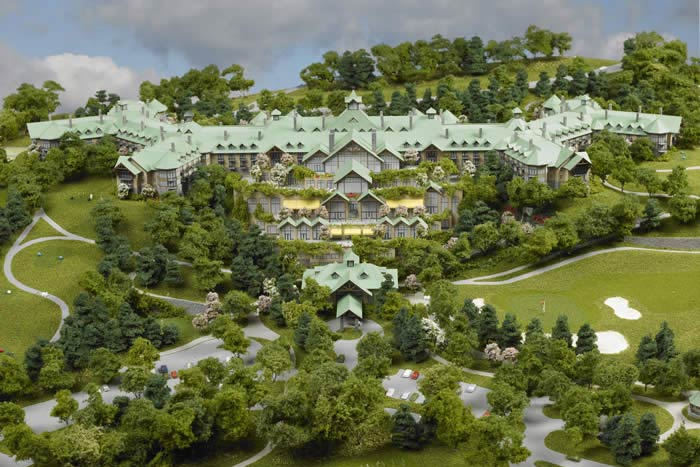
Artist’s rendering of the Wildacres Resort at the planned Belleayre Resort at Catskill Park. (courtesy of Belleayreresort.com)
Belleayre Resort
Where: Belleayre Mountain, adjacent to Belleayre Ski Center.
What: The resort, with a reported construction budget in the $50 million range, was first proposed by Catskills developer Dean Gitter in the late 1990s. It went through years of vociferous battles between those in support of local economic development and the Catskills’ many environmental stewards before a compromise “agreement in principle” was signed by most parties with then-governor Eliot Spitzer’s help in 2007. The size of the original project was halved, with Crossroads promising to sell some of its Catskill Park holdings to the state for Forever Wild protection, and the inclusion of the historic Highmount Ski Area in an expanded Belleayre Mountain Ski Center, which is state-owned.
The current configuration of the Belleayre Resort calls for two hotels on 740 acres that straddle the border of Ulster and Delaware counties. The Highmount portion will be a ski-in and ski-out 120-unit hotel with spa facilities, and nearly 100 time-share units and detached lodging units, while Wildacres, proposed to be newly built on the site of a former resort, would have a 250-room hotel, 163 other lodging units and an 18-hole golf course.
2019 forecast: We’d be surprised to see anything happen this year. The legal challenges that held up the project for decades are over, but that doesn’t mean construction will begin any time soon. Ken Pasternak, one of the development’s principal investors at Crossroads Ventures, said last last year that before the project can move forward the sale of privately-owned lands that once housed the Highmount Ski Area must first be finalized with the state, per previous agreements, and a resort developer/operator has to be signed on to take the project from its current conceptual status to a “ten-set CAD” level of plans needed for building permits.
Woodstock Library
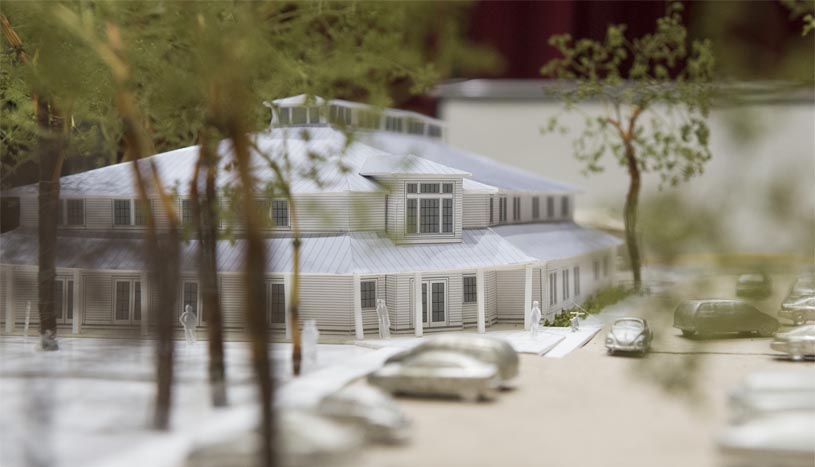
Architect Stephen Tilly’s proposal (photo by Dion Ogust)
Where: 5 Library Lane, same as current library
What: A new $4.8 million, 15,000-square-foot, two-story public library. Most of the current library will be razed. After weathering a referendum last fall that would have dissolved the library district, the library board chose a design for new library submitted by architect Stephen Tilly.
2019 forecast: The library board will be seeking funding for the project. That is likely to include donations and fundraisers, and possibly putting a bond before voters.
Poughkeepsie & Hyde Park
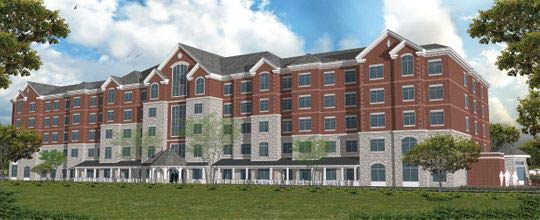
The Bellefield at Historic Hyde Park
Where: Route 9 in Hyde Park, from W. Dorsey Lane to St. Andrew Road, across the street from the Culinary Institute of America
Developer: Bellefield Development Partners
What: One of the largest developments on our list, and it’s definitely happening. The $500-million project features over 550 residences “ranging in architecture from brownstone-style homes to detached cottages to artist-style lofts” as well as “two hotels, culinary shops, farm-to-table restaurants, a special event barn and an educational center.” Forty-eight of the 340 total acres will be farmed, and more than half will remain undeveloped. Although the project isn’t affiliated with the Culinary Institute, developers are promoting its proximity and seeking related businesses to take commercial space in the development. Expect the restaurants to be top notch; an epicurean destination.
2019 forecast: Ground was broken last fall. According to the Poughkeepsie Journal, the first phase will be the construction of a 133-unit hotel and creation of infrastructure for future development. It will be complete in late 2019 or early 2020. There aren’t firm deadlines for subsequent phases.
Patient pavilion, Vassar Brothers Medical Center
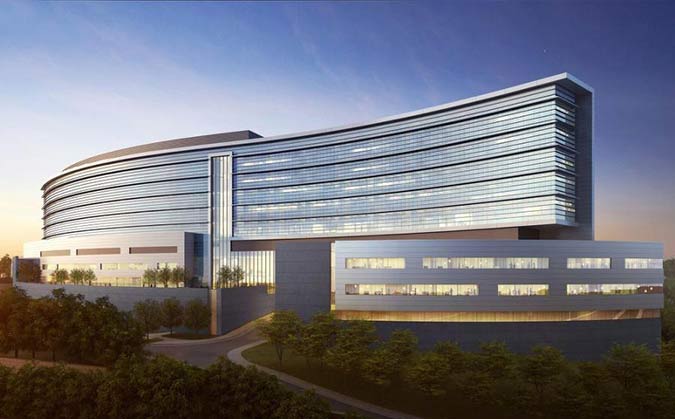
Where: Hospital site; Reade Place, Poughkeepsie; visible from Route 9 south of the Mid-Hudson Bridge
Developer: Health Quest Medical Practice
What: New $545-million,752,000-square-foot, eight-story patient pavilion. Touted by developers as the largest building project in Poughkeepie’s history. The new facility will allow Vassar Brothers to replace its outdated, obsolete medical/surgical units with a patient pavilion that will house 264 private medical/surgical patient rooms. Each room will be 330 square feet in size, compared to the 243 square feet found in the existing semiprivate rooms. Also included: a 66-bay emergency room/trauma center with approximately 58,000 square feet of space – almost twice the size of the current emergency room that treats 70,000 patients annually, 15 operating suites, a 72,000-square-foot, 30-bed Intensive Care Unit, visitors lounge, 240-seat cafeteria, outside seating areas, and a 300-seat community conference center for staff and visitors. Once open, the medical center will continue to have 365 total beds, the same number it has now. The difference will be those beds will be in all private rooms.
2019 forecast: Construction will continue through 2019, opening in early 2020.
Poughkeepsie Landing
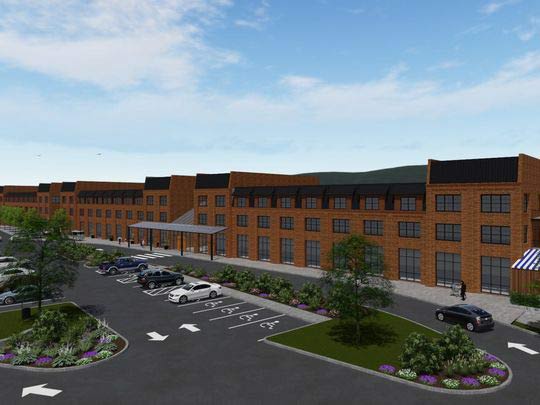
Where: Poughkeepsie waterfront, adjacent to Shadows on the Hudson
Developer: Bonura Hospitality Group, partnering with the city of Poughkeepsie
What: Promenade along the Hudson, outdoor amphitheater, public pool, public dock, retail and dining concourse. The promenade will be a public walkway ranging from 12 feet to 25 feet wide and over 2,300 feet long, linking the Walkway Over the Hudson to an already constructed promenade at Shadows on the Hudson.
2019 forecast: Still needs planning board approval. If that happens, construction could begin this year.
Dassai Sake brewery

Where: Corner of Route 9 and St. Andrew’s Road, Hyde Park
Developer: Asahi Shuzo / Dassai Premium Sake
What: $28-million, 55,000-square-foot sake brewery capable of producing 332,000 gallons of sake a year.
2019 forecast: Ground was broken late last year. Brewery and tasting room expected to open to public in early 2020.
Fallkill Commons on Rose
Where: Rose Street, Poughkeepsie
Developer: Hudson River Housing, Inc. A non-profit organization dedicated to affordable housing; also did the Underwear Factory, a mixed-use commercial and residential development on Cherry St., Poughkeepsie
What: A $22-million, 78-unit affordable housing project in two buildings. The units will consist of 41 studio apartments and 37 one-bedroom apartments starting at $500 a month. Thirty-nine apartments will be set aside for residents with mental illness.
2019 forecast: Construction now in progress; expected to be completed in 2020.
One Dutchess
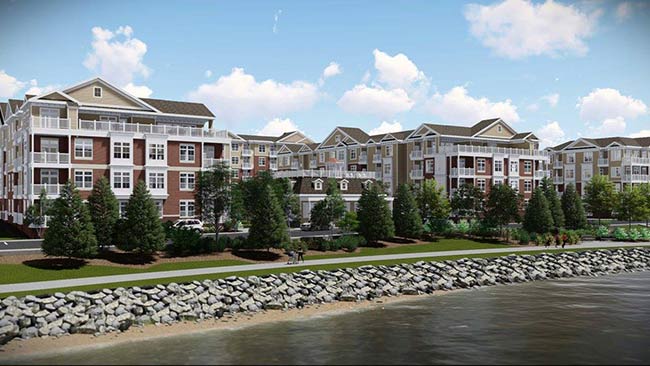
Where: One Dutchess Avenue, Poughkeepsie, on the Hudson
Developer: The O’Neill Group-Dutton LLC
What: Four-story, luxury apartment development. The entire project will be 300 units when complete.
2019 forecast: The first three buildings will open this spring, with several more buildings to be constructed later. Developers are accepting deposits for early spring occupancy.

Thanks for the resource. I had no idea about… well, most of these, other than a few in Kingston where I live. The topic came up at Christmas and nobody else seemed to know either.
A lot of assumptions about very rich people continuing to blow money on unnecessary holidays. When the next recession hits (which is overdue), most of these (other than the hospitals) will go into torpor, with most probably never being built. They may be the lucky ones. The ones that are built will have spent all their money when it hits. They’ll lose their shirts.
The past few decades have been good for the 1 percent but it’s coming to an end. We’re $20 trillion in debt and not producing anything of value for the rest of the world. There’s absolutely no reason for this to continue. Doesn’t mean we’re going to go into “survivalist” mode, but we aren’t going to need endless luxury condos, hotels, and other precious little getaways for the rich. Sorry landowners, those days and margins are over.
This area is very popular and we have been fortunate to have second home owners and visitors assisting with the local economy.
We turned a family dairy Farm into an Equestrian Community preserving the vistas of Mohonk and having over 50 acres of forever open space. This private community will have only 18 homes along with the state of art Equestrian Center. The center is separate from the homes. This concept provides over 10 million in new assessment, 300k in taxes, 150k year in local services, all with no children or town services.
Nice for the community.
Mr. Dendis doesn’t quite get it right: “Though as residents we can’t choose what developers and property owners propose, we can have some influence over whether it’s approved by the relevant local authorities. Every town and city has a zoning code that divides it into different sections and spells out what sort of development is allowed in each. There’s usually also a master plan that describes broader goals for development in the future. Residents who want to challenge proposed developments effectively base their arguments on these documents…Beyond that, many developments are proposed (or already exist) in areas where the zoning should prohibit them. They require variances and special-use permits, issued by local boards in public meetings following public hearings, offering residents further opportunities to influence the process.”
While public hearings are held for nearly every application, the public’s sentiments cannot be a deciding factor in the process. This means, should every resident attending a public hearing objects to the proposed development, for a review board to turn down an application due to public animosity, that decision would never prevail in an Article 78 lawsuit. Public hearings are primarily for identifying negative impacts so they can be mitigated. Those impacts must also remain in the realm of reality and not just be the wild imaginings of those living around a proposed project.
The zoning code is the determining factor when appraising any application. The time for residents to get involved is when the zoning code is being constructed. Not afterward as then it’s too late. What is allowed in the code trumps any kind of distaste for the project regardless if that opposition is unanimous; remember, too that public hearings only bring out a fraction of a town’s residents.
We often hear that “the people” are opposed when it’s only a small fraction of a percent that are against something. Yes they’re persistent and very vocal, often using social media to spread rumor and fear-mongering .And, yes, they’re usually NIMBY oriented complaints.
As for your comment that some projects are considered when prohibited by the code, no. That would require a Use Variance which is virtually impossible to obtain in New York State since 1992 case law that establishes the requirement for applicants to have to prove hardship– by competent financial evidence –that for each and every use allowed in that zoning district a reasonable return could not be had; and that doesn’t mean reasonable to the applicant but, rather, to a judge should a decision be challenged in court. Usually just selling the parcel for residential use would provide enough return to thwart the required proof of hardship.
If, in fact, Mr. Dendis knows of town review boards allowing prohibited uses where they’re not allowed, please follow up here with those projects. The proper way to go about something like that would be to request of a Town Board to consider a zoning change or use allowance change for the district where the applicant would like to do his/her project. That’s a whole process and also when the public’s input does the most good.
Of course, I do want to commend Mr. Dendis for this article. Very informative and proof that this area is seeing a rebound in growth. Every one of those projects seems a good fit for this area.
One other comment, re statement “we’d like to see development that creates a variety of good-paying jobs,” it might be instructive to actually state what those kinds of jobs would be. We all want “good paying jobs” but what are those jobs? Very difficult to pin down, thus the problem with development everywhere in this region. Also the source of vitriol against public officials for not getting “those” jobs.
Steven:
Thanks for your thoughtful critiques. I’ll do my best to answer them.
Variances
It’s true that they’re more often applied for than granted. And those that are granted are usually “area” rather than “use” variances, meaning the exceptions requested are for something like setback from road or property line rather than allowing a business in a residential area (which would be a “use” variance). I take your point that it might been clarifying if the article pointed out that this type of variance is rarely granted. However, I didn’t think they were “virtually impossible” to get. I admit I’m not a regular planning/zoning/business reporter or editor so I didn’t have any examples in mind when I wrote the introduction, just a general sense that I’d heard of variances being sought and granted from time to time.
Here’s what I could find for some local examples for use variances being granted:
Phoenicia school
https://hudsonvalleyone.com/2016/11/03/microbrewery-asian-restaurant-pre-school-taking-space-in-phoenicia-plaza/
“Because the plaza is zoned commercial/light industrial, which does not allow schools, [the owner of the school] had to apply to the Zoning Board of Appeals for a use variance. The variance was granted, and the project has received site plan approval from the Shandaken Planning Board.”
Kingston Boarding House
https://www.dailyfreeman.com/news/local-news/kingston-hearing-may-decide-fate-of-west-chestnut-street-boarding/article_cfda03aa-fa40-11e8-b349-4ff8190c9bc3.html
ZBA approved a use variance in October 2018 for a boarding house in a residential area.
Kingston neon light business
https://www.dailyfreeman.com/news/neon-light-art-business-gets-zoning-variance-to-operate-in/article_eb780807-883d-5feb-ba66-7b2a348b7c88.html
ZBA approved a use variance for business to operate in a residential area.
The relative paucity of ready examples supports your point. But I will say that area variances for height, setbacks or parking aren’t always granted, and they do offer residents who oppose projects the opportunity to stop them, or at least slow them down.
You write:
“While public hearings are held for nearly every application, the public’s sentiments cannot be a deciding factor in the process. This means, should every resident attending a public hearing objects to the proposed development, for a review board to turn down an application due to public animosity, that decision would never prevail in an Article 78 lawsuit. Public hearings are primarily for identifying negative impacts so they can be mitigated. Those impacts must also remain in the realm of reality and not just be the wild imaginings of those living around a proposed project.”
Of course you are correct that public sentiment isn’t grounds for rejecting a project. When I wrote:
“Residents who want to challenge proposed developments effectively [emphasis added] base their arguments on these documents. They can also question the findings and rigor of the environmental impact statement, a study required of all significant developments that spells out not just the effect on the natural world (as “environment” implies), but also the economic and social impacts.”
I was trying to contrast the type of opposition that is rooted in what the zoning law says with the type of opposition that says simply “I don’t want this development here.” For example, if 40 neighborhood residents show up and say they don’t want a halfway house in the neighborhood because they don’t want to live next to ex-cons, that’s not going work (assuming a halfway house is a permitted use). But if one of the neighbors understands this and organizes the opposition to focus its arguments on aspects of the proposal that may be questionable under the zoning code, then public opposition can effectively sway the decisions of local planning boards. The board may not outright deny the project due to this, but it may be more likely to continue to add more requirements for study, landscaping, another site plan review due to changes, and so on. All of this costs time and money and may persuade a developer to give up and look for another site in a town or city known for a more “business friendly” attitude.
On “good-paying jobs”
I suppose everyone has their own definition. A view I hear a lot is that it would be better if there were more industries paying high enough salaries that young people born in the area wouldn’t feel that they needed to move elsewhere to make a good living, especially if they hold a four-year degree, and that development in the residential and hospitality area doesn’t generate a lot of these kind of jobs. There are a lot of holes in that argument. It doesn’t take into account that every social and economic trend is pushing young people and companies toward centralization in a few urban clusters, or that there are plenty of opportunities to make a good living around here with or without a college degree, they just don’t fit the mid-20th-century, large commercial/industrial firm model. Still, it’s something that comes up a lot so I wanted to acknowledge it.
Excellent update, William. I wrote what I did in an effort to educate the public. I commend you for doing the same by tackling this issue.
I have been involved with zoning/planning issues for 30 years. Served as Town of Rochester Planning Board chairman and currently the town’s ViceChair of the ZBA. Plus just graduated from the Land Use Leadership Alliance program affiliated with Pace Law School and have undertaken countless hours of training in the field.
I wanted to clarify the points I brought up because so many people think that by complaining en masse they can stop a project. As you remarked, not the case. Plus, it is rarely a good idea to band together in an “anti” group with names like “No Whatever Project” as that demonstrates an immediate bias against the project that should it end up in court, a judge will not look kindly upon as the obvious intent of the anti group is to stop the project rather than assure it’ll fit with the code and community.
Also, you’re correct re Area Variances being turned down IF said variance causes a negative impact on the neighborhood, was a self-created hardship (meaning the issue existed when property was purchased), could be done some how differently (usually via placement change) without gaining a variance.
BTW, two of those Use Variances re Neon light company and the Kingston Boarding House were in absolute violation of law but weren’t challenged by neighbors (with legal standing). In the case of the Neon Light company, the owners of the synagogue in which the company used for production facility was never required to show via competent financial evidence that it could not make a reasonable return for EACH AND EVERY allowable use in the district. That building is smack in the middle of a residential area and could have easily been sold as a residential building thereby affording the reasonable return aspect. As for the Boarding House, an appeals court ruled it an illegal use yet the ZBA defied that ruling and allowed it, again without going through the competent financial evidence requirement. No doubt about those two. As for the Phoenicia case, it appears that it was not done according the NYS law as regards Use Variance criteria. The proper way to have gone about that situation would have been for the school proposition to go before the town board requesting school use be added to the light industrial district via Schedule of Use inclusion w/definition of school. That the ZBA granted a Use Variance shows it was not legally done, again because the proper criteria were not applied.
Also, a major difference between Area Variance and Use Variance is that an area variance is subjective in that an applicant may not meet all the criteria and still get an approval while a Use Variance requires every criterion be met.
I hope you keep on writing about zoning/planning issues as they really do impact peoples’ lives.
Excellent, informative summary….thanks.
This editorial is astounding! After pointing the mighty NIMBYfinger at dreaded “wealthy outsiders”
as the cause for new development in our area the full listing of what’s being built reveals more than
50% of the projects are directly aimed at “locals”. Hospitals, Housing for the Eldery and Disabled,
Housing for Lower Income Residents; The “local” Cultural and Arts Community is proposing the
Irish Cultural Center, not outsiders. The remainder are logically, rationally, and uneventfully normal in
that a locality would expect to see new lodging, new market-rate housing, and new businesses. It’s
called economic development.
Seriously!? The dismal attitude and elitism of the “locals” is insulting, primarily because it is so laced with
snobbery and ignorance. Shame on you. You can have outdated hospitals, no housing for the under-earning population, and no new jobs if that’s what you really want. I think we call that biting off your nose in spite of your face.
One has to marvel at just what “locals” would build here? Public housing, Stewart’s Shops, and Car
dealerships? We’ve got plenty of that already. Albany Avenue is a bleak strip of these things…oh, that many
of the evil wealthy tourists stop for gas and buy cars here…more jobs, more tax revenue…but you don’t want to hear that, do you?
Here’s the facts, and the deal. Ulster County’s population, including a full 1/3 or more who consider themselves “locals” are actually transplants, not only from the NY metro area — Reminder: Ulster county IS PART OF THE NY metro area: We call it a suburb. We aren’t in the wild West, we aren’t in Montana, we are pioneers forging a new and unknown territory. We are in fact one of the NYC metor area’s suburban counties. So deal with it.
Add to that — the horrible “toursits” we love to bach account for approx. $1 BILLION IN ANNUAL REVENUE FOR us locals. That’s right! That is thousands of jobs for “locals” who use that income to pay rent, mortgage, and survive as employed, productive members of society.
This “us vs. them” attitude has got to stop. It’s ridiculous, and I’ll tell you this, you want more than 1/3 of
business, home ownership, more than 50% of all tax revenue to go away…be very, very wary of what you wish. This leaves you with an empty mall, an abandoned and toxic IBM site, empty abandoned residential properties, and public social services that the locals use but won’t be financed.
And for this publication, the continual support of this attitude is foolish. You’re doing nothing more than
perpetuating the lie of division here. So, shame on you, too.
The “keep Out” attitude of some people around here is nothing more than foolish pride entrenched in ignorance.
You do no one – including yourself – a service by disparaging natives of the area.